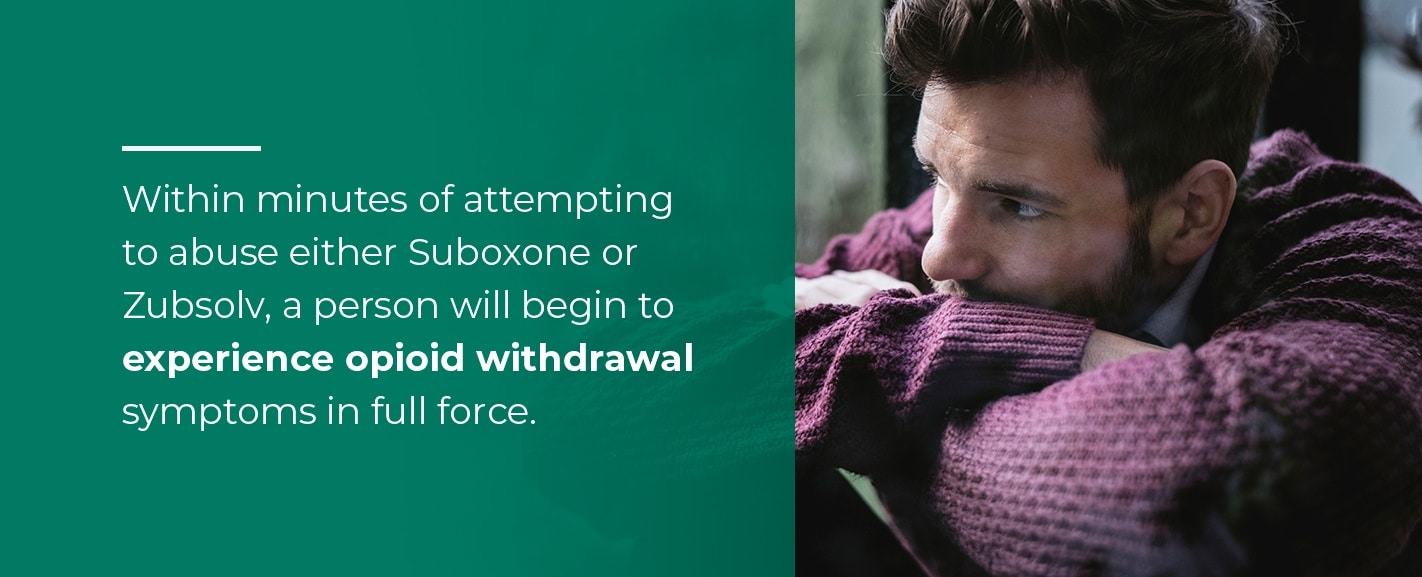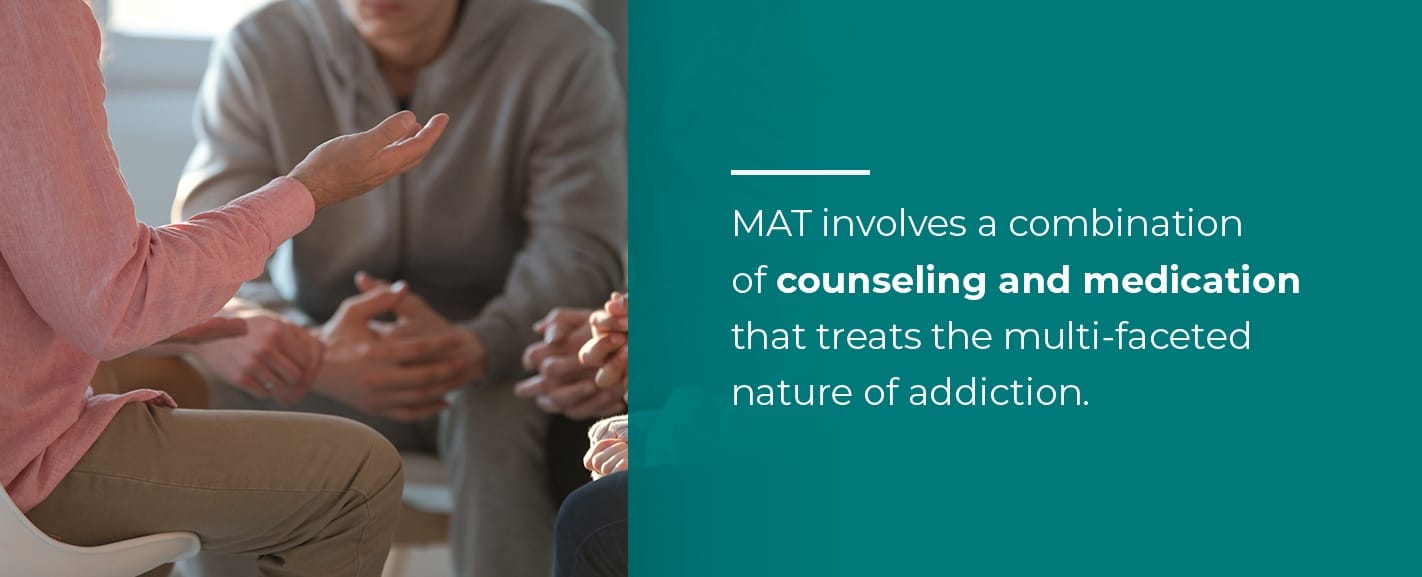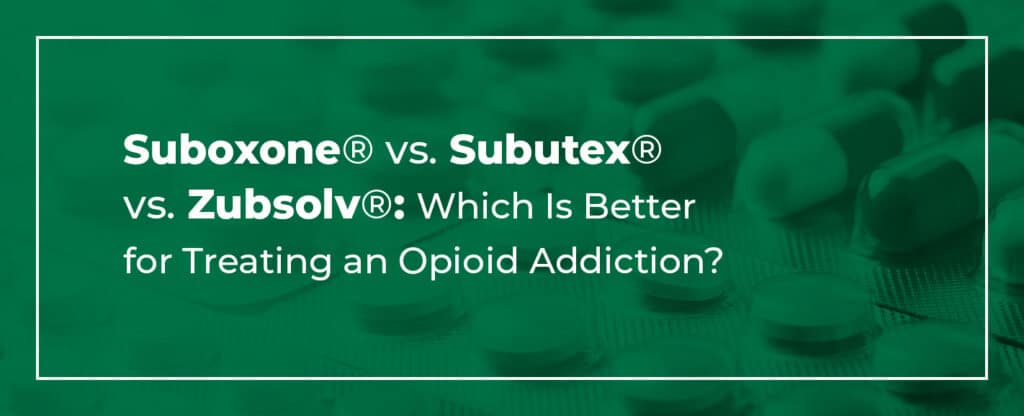In 2002, the Food and Drug Administration approved buprenorphine for use in medication-assisted treatment (MAT) for opioid addiction. Buprenorphine is a partial opioid agonist, which means it binds partially to specific opioid receptors in the brain and activates those receptors, but to a lesser extent than full agonists like Oxycontin or heroin.
Switching to buprenorphine from a drug like morphine, heroin or prescription painkillers allows people to stop misusing drugs without the extreme withdrawal symptoms that can make recovery excessively challenging. Suboxone, Subutex and Zubsolv are all MAT medications containing buprenorphine, and understanding the differences will better equip you to make decisions about treatment.
What Is Subutex®?
Subutex is buprenorphine alone, known as a mono-product. It comes as a white tablet that is dissolved under the tongue. Unlike some other forms of buprenorphine, Subutex was not originally developed to provide any form of pain management. It provides relief from opioid withdrawal symptoms but does not include the deterrent properties associated with Suboxone.
What Is Suboxone®?
Suboxone is a combination of buprenorphine hydrochloride and the compound naloxone, sometimes referred to as a dual-product. The government approved Suboxone in 2012 as an alternative to Subutex, the mono-product or generic buprenorphine. The main difference in Suboxone vs. Subutex is that Subutex had a higher possibility of misuse due to its lack of naloxone.
Suboxone is a thin buccal film users place under the tongue to dissolve. The body’s oral mucosa effectively absorb the medicine into the body.
What Is Zubsolv®?
Zubsolv received approval one year after Suboxone, and was its first direct competitor as it contains the additional ingredient naloxone. Like Subutex, Zubsolv is a sublingual tablet to be dissolved in the mouth.
Comparing the Three Forms of Treatment
All three medications are available for treatment and a medical provider works with patients to determine the best option for them. In terms of formulation and administration, the two dual-product medications are quite similar. For many people, the choice comes down to whether they prefer the buccal film or sublingual tablet. Those who have struggled with prescription painkiller addiction may find the tablet shape of Zubsolv is somewhat triggering and opt for Suboxone for that reason.
Dosage Differences
In terms of dosage, there is not a huge difference between Suboxone and Zubsolv. Zubsolv comes in six dosages distinguished by unique shapes. It has a 4:1 ratio of buprenorphine to naloxone. The dosages are as follows.
- Oval shape: 0.7 mg buprenorphine / 0.18 mg naloxone
- Triangular shape: 1.4 mg/0.36 mg
- D shape: 2.9 mg/0.71 mg
- Round shape: 5.7 mg/1.4 mg
- Diamond shape: 8.6 mg/2.1 mg
- Capsule shape: 11.4 mg/2.9 mg
Like Zubsolv, Suboxone has a 4:1 ratio of buprenorphine to naloxone. However, the Suboxone sublingual film comes in only four dosage strengths.
- 2 mg buprenorphine / 0.5 mg naloxone
- 4 mg/1 mg
- 8 mg/2 mg
- 12 mg/3 mg
The most significant difference between the two is that Zubsolv is more potent. It has higher bioavailability than Suboxone, meaning it is easier for the body to absorb. A smaller dose of Zubsolv can enable users to attain the same effect as a larger Suboxone dosage.

Potential for Abuse
The U.S. government categorizes all three medications as Schedule III controlled substances, as they all have some potential for misuse.
The addition of naloxone to both Suboxone and Zubsolv is an abuse-deterrent. Taking naloxone orally does not produce any ill effects, but if someone dissolves a tablet or sublingual film for injection or crushes a tablet to snort, the naloxone immediately precipitates withdrawal. Within minutes of attempting to abuse either Suboxone or Zubsolv, a person will begin to experience opioid withdrawal symptoms in full force. The experience can involve:
- Agitation and anxiety
- Aching muscles
- Excessive tearing in the eyes
- Sweating
- Runny nose
- Abdominal cramps
- Nausea and vomiting
- Diarrhea
- Goosebumps
Rather than getting high from either medication, someone abusing them will enter a state of withdrawal that may take several hours to abate. Naloxone has a stronger affinity for opioid receptors than almost any other opioid, so attempting to alleviate the withdrawal symptoms with heroin or a prescription painkiller will not work. Thanks to this strong deterrent effect, Suboxone and Zubsolv both have a lower potential for abuse than methadone, another common medication used in MAT.
Side Effects
Every drug has potential side effects. Because Zubsolv and Suboxone consist of the same active ingredients in the same ratio, they have similar potential side effects such as:
- Dizziness
- Drowsiness
- Feeling drunk
- Difficulty concentrating
- Tongue pain, redness or numbness of the mouth
- Nausea, vomiting or constipation
- Headache and back pain
- Fast or pounding heartbeats
- Increased sweating
- Insomnia or other sleep problems
The side effects of these medications are usually mild enough that they aren’t a major factor in choosing between Zubsolv and Suboxone for opioid addiction.
Treatment With Suboxone®, Subutex® and Zubsolv®
All buprenorphine based treatment medications are available in a number of different types of treatment programs and in some physician offices. These medications can be part of a residential treatment program, but many people choose this form of MAT because it is also highly effective in an outpatient setting. When participating in an outpatient MAT program, patients can retain independence and fit treatment into their busy lives.

MAT involves a combination of counseling and medication that treats the multi-faceted nature of addiction. It is the most effective form of intervention for opioid use disorder — more effective than behavioral or medication-based interventions alone.
While the medication works to keep people stable and shielded from the pain of withdrawal, different forms of counseling help participants unravel the roots of their addiction and learn the coping skills necessary to live a life free from drug abuse. Quality MAT programs provide people in recovery with services including:
- Individual counseling for opioid addiction
- Group and family counseling
- Planning for relapse prevention
- Case management
- Referral to community resources
With these tools in hand, participants can build a strong and lasting recovery through MAT.
Opioid Addiction Recovery at MedMark
Struggling with opioid addiction is a frightening and often isolating experience, but you don’t have to do it alone. MedMark Treatment Centers has multiple clinic locations around the United States to help people like you achieve lasting sobriety. It’s completely natural to have further questions about MAT using buprenorphine compounds like Suboxone and Zubsolv, so don’t hesitate to reach out with any inquiries you may have about buprenorphine treatment.
You deserve compassionate, evidence-based care from an accredited and trusted treatment center like MedMark. Call us today at 866-840-6658 or contact us online to start on your path to a drug-free life.




